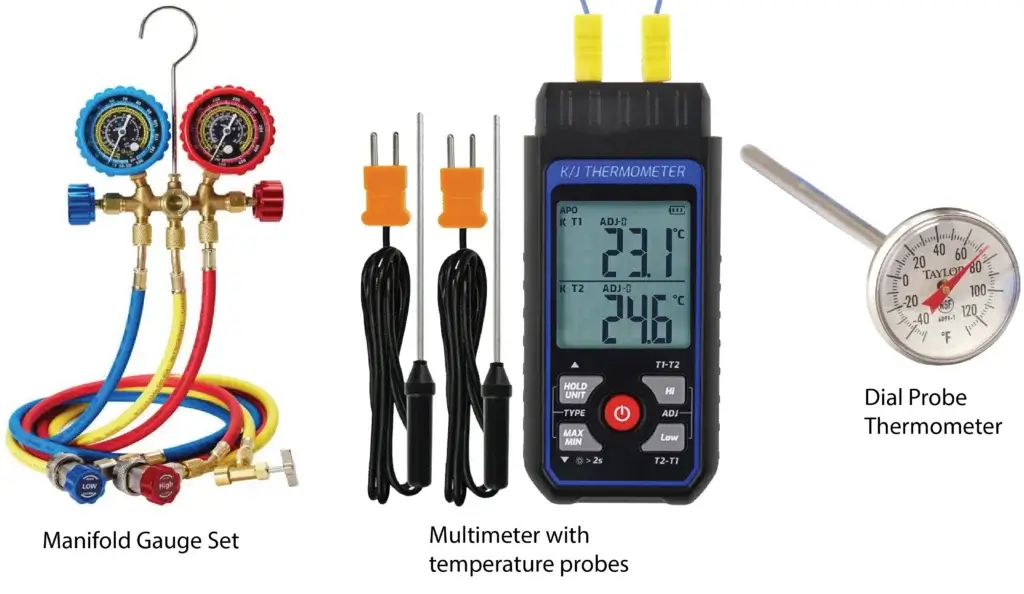Fix Your Car’s AC Yourself: Troubleshooting Tips
How to diagnose and fix your car’s AC yourself and save a bundle
Auto AC systems are fairly simple, and if you have the proper tools, you can isolate the problem and fix your car’s AC yourself, saving thousands. Almost all car AC problems start out as a refrigerant leak. But continuing to drive on a low refrigerant is what causes the most damage. So the key to keeping your system working all summer long is locating the leak and fixing it before it damages other components.
Must have tools for diagnosing and fixing car AC problems yourself
• A manifold gauge set. You can’t diagnose an AC system using just the low-side pressure readings. Manifold gauges are cheap to buy and even cheaper to rent.
• Temperature probes — This one is really important if you’re getting some cooling but not really cold air. In order to diagnose this, you have to test the temperatures in certain locations around the AC system. Non-contact infra-red thermometers don’t work well for these tests.
• Analog dial or digital thermometer — This one goes in the center vent to get an accurate read of how well the system is working.
Where to start diagnosing your car AC problems
Step 1: Find out what type of refrigerant and oil your vehicle uses
Most cars and trucks from the 90’s until around 2017 used R-134a refrigerant. That refrigerant is inexpensive and easy to buy at any auto parts store. But late-model vehicles use a more planet-friendly R-1234yf. It’s expensive, so you really want to find and fix the leak.
Many hybrid and electric vehicles use an electric AC compressor that requires a special oil
Older hybrid systems still use R-134a refrigerant but they use a different oil. If you try to recharge those systems with a DIY AC recharge kit that contains conventional oil, you can cause all kinds of damage to the electric compressor and even possibly electrocute yourself In the process. If you’re hell-bent on recharging the AC in your hybrid that’s equipped with an electric compressor, you MUST purchase refrigerant that doesn’t contain oil.
Step 2: Find out if your system uses a magnetic compressor clutch
All older systems use a magnetic compressor clutch to disengage the compressor when the system is off or cooling needs are low. However many newer vehicles use a “clutch-less” variable displacement compressor. The pulley and compressor shaft on those compressors rotates any time the engine is running, even if the AC is turned off. That may seem like a waste of energy, but this type of compressor has a vacuum or electrically operated valve that only allows refrigerant flow into the compressor when the system is turned on. When the valves are off, the compressor is basically free-wheeling and uses very little energy.
If you don’t check the clutch type ahead of time, you can easily misdiagnose the system by thinking that a clutch-less compressor is pumping refrigerant when it’s free-wheeling.
Step 3: Start your diagnosis by inserting a probe thermometer into the center duct on your dash
1. Engine running at normal operating temperature
2. Set AC to MAX and blower to RECIRCULATE
3. Close all windows and doors.
4. Set blower to highest speed
5. Leave the thermometer in place for at least three minutes and record the temperature.
The center duct temperature should be at least at least 40°F or cooler.If the center duct temperature is higher than 40°F, there’s a problem
Step 4: Check high and low side refrigerant pressures using the manifold gauge set
Here’s a link to normal pressure readings: Normal car AC pressures
And a link to abnormal pressure readings and possible causes: Abnormal AC pressure readings
Step 5: Checking the superheat temperature is the single most accurate way to diagnose the root cause of all car AC problems.
If the gauge pressure are off, you’ll have to find out why. Most DIYers and even many pros skip this step. But a superheat test is the Gold-Standard in diagnosing the root cause of all car AC problems. The superheat temperature readings tell a lot more about how the system is operating than pressure gauges. Think of them like lab results from a blood draw that tells the condition of the patient.
How to test superheat on an expansion valve system, Click here
How to test superheat load on an orifice tube system. Click here
©, 2020 Rick Muscoplat
Posted on by Rick Muscoplat
